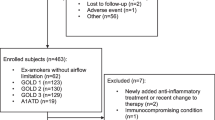Abstract
Pi phenotype was determined and α1 protease inhibitor (α1Pi) was measured in 871 iron-ore miners examined twice at five years interval.
A questionnaire on respiratory symptoms was administered and lung function tests: spirometry (VC, FEV1.0), measurements of the residual volume (RV/TLC) and of the CO diffusion (FuCO), were carried out by the same medical and technical team, using the same apparatus.
There were no differences in age, lenght of employment or smoking habits among the three Pi Phenotype groups: M (90:03%), MS (7.1%), MZ (2.8%). The prevalence of clinical symptoms at the initial survey and the incidence of symptoms between the 2 surveys were not related to Pi Phenotype groups. However a significantly steeper decline of FEV1.0/VC was observed in the α1Pi partially deficient groups MS and MZ (−3.9%) compared with the non-deficient group (−1.8%). No significant difference was observed for VC, RV /TLC and FuCO.
This finding suggests that an intermediate deficiency of α1Pi may be related to a slight but statistically significant impairment of a lung function in occupational conditions.
Similar content being viewed by others

References
BeatyT.H., MenkesH.A., Cohen B.H. et al. (1984): Risk factors associated with longitudinal change in pulmonary function. - Am. Rev. Respir. Dis., 129: 660–67.
BeckmanG., BeckmanL., Mikaelsson B. et al. (1980): Alpha-1-antitrypsin types on chronic obstructive lung disease in an industrial community in Northern Sweden. - Hum. Her., 30: 299–306.
Brille D., Casula D., Van Der Lende R., Smidt U., Minette A. (1971): Questionnaire pour l'étude de la bronchite chronique et de l'emphysème pulmonaire. Edit. CECA Luxembourg.
CamaraM., MartinJ.P. (1978): Le déficit en α1 AT et son retentissement en pathologie pulmonaire.- Bull. Europ. Physiopath. Resp., 14: 91–124.
CECA (1971) : Aide mémoire pour la pratique de la fonction ventilatoire par la spirographie. Collection d'Hygiène et de Médecine du Travail n° 11, 2ème édition., Edit. CECA Luxembourg.
Chan-YeungM., AshleyM.J., Corey P. et al. (1978): Pi phenotypes and the prevalence of chest symptoms and lung function abnormalities in workers employed in dusty industries. - Am. Rev. Respir. Dis., 117: 239–45.
CharlionetR., MartinJ.P., Sesboue R. et al. (1979): Synthesis of highly diversified carrier ampholites. -J. Chromat., 176: 89–101.
ColeR.B., NevinN.C., Blundell G. et al. (1976): Relation of alpha-l-antitrypsin phenotype to the performance of pulmonary function tests and to the prevalence of respiratory illness in a working population. - Thorax, 31: 149–57.
HortonF.O., MackenthunA.V., Anderson P.S. et al. (1980): Alpha-1-antitrypsin heterozygotes (Pi-type MZ). A longitudinal study of the risk of development of chronic airflow limitation. - Chest, 77(Suppl.): 261–65.
KauffmannF. (1984): Genetics of chronic obstructive pulmonary diseases: searching for their heterogeneity.- Bull. Eur. Phys. Resp., 20: 163–210.
KueppersF. (1976): Alpha-1-antitrypsin phenotyping by isoelectric focusing in polyacrylamide gel. -J. Lab. Clin. Med., 88: 151–55.
LiebermanJ., GaidulisL., MittmanCh. (1972): Identification and characteristics of the common alpha-1-antitrypsin phenotypes. - Chest, 62: 557–64.
OstrowD.N., ManfredaJ., Tse K.S. et al. (1978): Alpha-1-antitrypsin phenotypes and lung function in a moderately polluted Northern Ontario Community.- Can. Med. Ass. J., 118: 669–72.
PhamQ.T., MurJ.M., BeigbederP., DeniauR., LeonetO. (1977): Incidence à long terme de basses teneurs de nuisances gazeuses sur l'appareil respiratoire. Résultats d'une enquête épidémiologique chez des ouvriers des mines de fer du Bassin de Lorraine. - Rev. Epidemiol. Sté Publ., 25: 255–73.
PhamQ.T., MurJ.M., TeculescuD., ChauN., GaertnerG., HenquelJ.C. (1986): A longitudinal study of symptoms and respiratory function tests in iron miners. - Europ. J. Resp. Dis., 69: 346–354.
RosehallL., BackmanG., Stienberg N. et al. (1979): Chronic Bronchitis in sulphite pulp factory workers with heterozygous alpha-l-antitrypsin deficiency.- Br. J. Dis. Chest, 73: 426.
TattersallS.F., Petrik PereiraR., Hunter D. et al. (1979): Lung distensibility and airway function in intermediate alpha-1-antitrypsin deficiency Pi MZ. -Thorax, 34: 637–46.
Valeurs limites pour les concentrations des substances dangereuses dans fair des locaux de travail. In: Cahiers de Notes Documentaires 1984; 114: 63–94.
Author information
Authors and Affiliations
Rights and permissions
About this article
Cite this article
Pierre, F., Ham, Q.T., Mur, J.M. et al. Respiratory symptoms and pulmonary function in 871 miners according to Pi phenotype: A longitudinal study. Eur J Epidemiol 4, 39–44 (1988). https://doi.org/10.1007/BF00152690
Issue Date:
DOI: https://doi.org/10.1007/BF00152690



